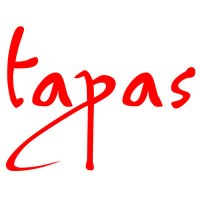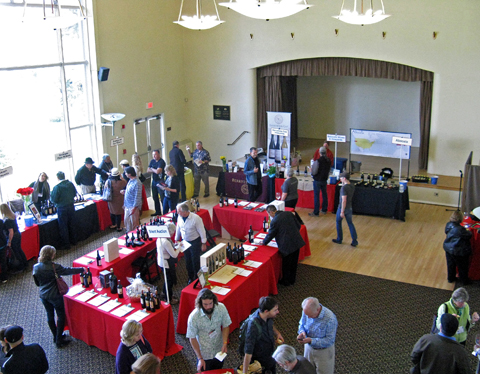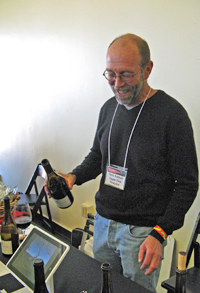Abacela Vineyards and Winery
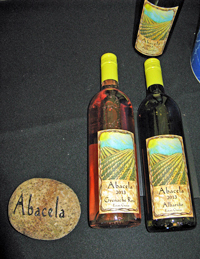 |
Abacela 2013 Albariño, Estate, Umpqua Valley, Southern Oregon. Light straw color, with bright citrus aromas with an herbal note. Lighter weight and lively on the palate, this had a saline quality and a slightly chalky mineral quality on the finish, nice.
Abacela 2013 Grenache Rosé, Estate, Umpqua Valley, Southern Oregon. Destemmed and left on the skins for about 12 hours, then pressed into stainless steel. Light salmon/pink color, with strawberry, fresh herbs, and a slight floral note on the nose. Lighter-bodied with a vibrant mouthfeel and crisp finish, nice.
Abacela 1997 Tempranillo, Estate, Umpqua Valley. Fermented in one ton batches at relatively high temperature (93°), blended with 5% Graciano. Ripe blackberries and dark plums, very savory with tobacco and dried underbrush, still quite lively and fresh. (Tasted at the Tempranillo seminar)
Abacela 2009 Tempranillo, Estate, Umpqua Valley. 95% Tempranillo with Petit Verdot and Malbec, from a cooler vintage, aged 25 months in mostly French oak (20% new) to help tame the tannins, dark berry and cherry fruit, with spice, chocolate, and a little bit of oak. Round tannins that are noticeable, but have softened enough that the wine is quite approachable. (Tasted at the Tempranillo seminar)
Abacela 2009 Tempranillo, “South East Block Reserve,” Estate, Umpqua Valley, Southern Oregon. Aged in more new oak than the Estate bottling. Medium color, this had a riper and higher-toned fruit profile than the regular Estate bottling, along with more spice and vanilla/oak. Slightly richer mouthfeel with a grippy tannic finish.
Abacela 2009 “Paramour,” Estate, Umpqua Valley, Southern Oregon. A reserve Tempranillo-based wine, this is the first “Paramour” bottling since 2005. Medium purple color, with plum, earth, spice, and vanilla/oak aromas. Medium-full bodied with lots of structure and a firmly tannic finish, this will need plenty of time in the cellar to show its best.
Comments: Earl and Hilda Jones planted the first Tempranillo in the Pacific Northwest in 1995, and have been leaders among wineries making wine from Iberian grape varieties ever since. Earl was one of the founders of TAPAS and its first president.
Baiocchi Wines & Vineyards
gb 2012 “G minor,” Fair Play. 44% Grenache, 32% Syrah, 24% Tempranillo, co-fermented and to be released this fall. Medium purple color, this featured ripe red and black fruits, spice, and a touch of sweet oak on the nose. Medium-bodied with a lively mouthfeel, finishing with firm tannins that should smooth out a bit by the time this wine is released.
Baiocchi 2010 “Orellana,” Baiocchi Family Vineyards, Fair Play. 60% Tempranillo, 40% Grenache. Medium color, showing ripe black cherry, earth, and dried herb aromas. Big and structured on the palate, with good acidity and chalky tannins on the finish, another wine that should improve with some bottle age.
Comments: Greg and Sharon Baiocchi’s first vintage for their winery was in 2009. Grenache, Syrah, Mourvèdre, and Tempranillo were planted in the granitic soil at their 12-acre Sierra Foothills vineyard in 2006. Greg had previously worked at Miraflores in El Dorado County and at Big Basin in the Santa Cruz Mountains. I’d tasted a few of their other wines recently and tried only these two on this occasion.
Bodegas Paso Robles
Bodegas Paso Robles 2002 “Solea,” Central Coast. From the winery’s first vintage, roughly 90% Tempranillo and 10% Graciano from the Cienega Valley, dark plum and blueberry, earthy, mellow tannins and probably drinking at its peak. (Tasted at the Tempranillo seminar)
Bodegas Paso Robles 2009 “Solea,” Central Coast. Tempranillo with 14% Graciano, 23 months in barrel, mostly French with a little Virginia oak, ripe berry and plum, spicy, fresh acidity with some fine grained tannins. (Tasted at the Tempranillo seminar)
Comments: Bodegas Paso Robles owner/winemaker Dorothy Schuler was on hand for the event. The wines are made exclusively from Iberian grape varieties, and the winery’s first vintage was from 2002.
Bokisch Vineyards
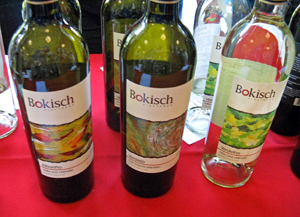 |
Bokisch 2013 Albariño, Terra Alta Vineyard, Clements Hills-Lodi. 98% Albariño, 2% Garnacha Blanca, made entirely in stainless steel. Very light color, very aromatic pear, stone fruit, and fresh herbs. Light and lively but with a slightly creamy texture, this had a crisp finish, nice.
Bokisch 2013 Verdelho, Vista Luna Vineyard, Borden Ranch-Lodi. 95% Verdelho, 5% Verdejo, made entirely in stainless steel. Very light straw color, this had tropical fruit, flowers, and spice on the nose. Medium-light weight and lively, with a smooth, fresh finish, nice.
Bokisch 2013 Verdejo, Clay Station Vineyard, Borden Ranch-Lodi. 100% Verdejo, made entirely in stainless steel. Very light color, featuring lemon and grapefruit notes along with a hint of spice. Medium-light bodied with good acidity and clean finish, nice.
Bokisch 2013 Garnacha Blanca, Vista Luna Vineyard, Borden Ranch-Lodi. 90% Garnacha Blanca, 10% Albariño, made entirely in stainless steel. Very light straw color, with green apple and herb aromas with a touch of citrus zest. Slightly richer mouthfeel but with crisp acidity and a spicy note on the finish, nice.
Bokisch 2012 Garnacha, Clements Hills-Lodi. 96% Garnacha, 4% Graciano, aged 18 months in French and American oak. Lighter garnet color, showing bright red fruits, spice, earth, and a touch of oak on the nose. Medium-light bodied and lively on the palate, finishing with milder tannins, nice.
Bokisch 2011 Monastrell, Belle Colline Vineyard, Clements Hills-Lodi. 90% Monastrell, 5% Garnacha, 5% Graciano, aged 18 months in French and American oak. Medium purple color, this had slightly floral notes along with plum, earth, and iron. Medium-bodied with refined tannins.
Bokisch 2011 Graciano, Lodi. 90% Graciano, 5% Garnacha, 5% Tempranillo, sourced from Las Cerezas & Terra Alta vineyards, aged 18 months in French and American oak. Medium-dark color, earthy and stone mineral notes were upfront, with dark berries, spice, and a touch of vanilla/oak in support. Medium-full bodied and structured, with a grippy tannic finish – nice now and should improve with bottle age.
Bokisch 2011 Tempranillo, Lodi. 90% Tempranillo, 10% Graciano, aged 18 months in French and American oak. Medium-dark purple, showing more oak and spice on the nose than the previous reds, along with plum and blueberry fruit, pepper, and dried herbs. Medium-full bodied, finishing with firm tannins.
Comments: Markus and Liz Bokisch established Bokisch Ranches in the Lodi area in 1996, and produced their first wines in 2001. One of California’s leaders among wineries specializing in Iberian grape varieties, the Bokisch Ranch vineyards in the Lodi area are all farmed organically. The Verdejo was the first Bokisch release from this grape variety, and there were more blends this year as opposed to 100% varietal wines. This was an outstanding line-up of wines, particularly the whites.
Caduceus Cellars
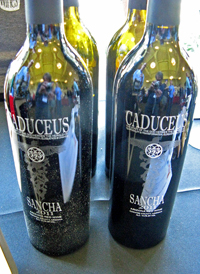 |
Caduceus 2012 “Dos Ladrones,” Bonita Springs Vineyard, Graham County, Arizona. 50% each Malvasia and Chardonnay, whole-cluster pressed and co-fermented. Medium-light straw color, this had intense floral aromas along with stone fruit and spice, plus a touch of vanilla/oak. Medium-rich mouthfeel and finish – as with the 2011 vintage the Malvasia came out more in the aromatics while the Chardonnay seemed to dominate on the palate and finish, an interesting blend.
Caduceus 2011 “Sancha,” Cochise County, Arizona. 85% Tempranillo, 15% Garnacha, aged 15 months in puncheons. Medium purple color, with ripe red black cherry fruit, earth, and herbs on the nose. Medium-full bodied with good structure, showing a stony mineral note and firm but refined tannins on the finish, nice.
Comments: Caduceus is located in the Verde Valley in central Arizona, though fruit is sourced from various locations. Owner/winemaker Maynard James Keenan (he’s also a famed rock vocalist, best-known for his work with the band Tool) produced his first wines from the 2004 vintage. Arizona Stronghold winemaker Tim White was on hand to pour the wines at the event.
Core Wine Company
Core 2009 “Hard Core,” Santa Barbara County. New release with a different blend than previous vintages – mostly Tempranillo with Mourvèdre and Cabernet Sauvignon, plus a little Syrah and Grenache. Medium-dark purple, this had ripe and higher-toned plum and darker berry fruit, spice, and dried herb aromas along with a touch of sweet oak. Medium-full bodied with a firm tannic finish.
C³ 2006 “Crazy Eights,” Santa Barbara County. 78% Tempranillo, 11% Merlot, 11% Cabernet Sauvignon. Medium-dark color, with herbal notes up front, followed by earth, black cherry and currant, and spice. Moderately rich mouthfeel, finishing with fairly big but refined tannins.
Core 2008 “Elevation Sensation,” Alta Mesa Vineyard, Santa Barbara County. 82% Grenache, 18% Mourvèdre. Medium-light color, showing more earth and spice notes plus red fruits and vanilla/oak in the background. Medium-bodied with a brighter mouthfeel and a chalky mineral note on the finish, should continue to improve with more time in the cellar.
Comments: Core’s Dave Corey poured wines from both the Core and C³ labels. Alta Mesa Vineyard is located at over 3,000-foot elevation in far-eastern Santa Barbara County. The winery was launched in 2001, and they have been working with longer barrel-aging for the reds in recent years. The “Elevation Sensation” was my favorite of the three wines I tasted.
Dos Cabezas WineWorks
Dos Cabezas 2013 “Pink,” Cochise County, Arizona. 85% Garnacha, 15% Monastrell, farmed specifically for this wine. Very light salmon/peach color, featuring ripe raspberry and spice aromas. Medium-light weight on the palate, with a bit of tannic bite on the finish.
Cimarron 2010 “Rojo del Sol,” Cochise County, Arizona. 50% Tempranillo, 25% each Garnacha and Monastrell. Medium color, with ripe plum and darker berry fruit, spice, and earth. Medium-bodied with a grippy tannic finish.
Dos Cabezas 2011 “Águileón,” Cimarron Vineyard, Cochise County, Arizona. 88% Tempranillo, 6% Graciano, 6% Mourvèdre. Medium purple, this showed lots of vanilla/oak on the nose, along with dried herbs, spice, and black cherry fruit. Medium-full bodied, with more oak dominating the flavors, finishing with firm tannins.
Comments: Dos Cabezas, established in 1995 in southeastern Arizona, has been producing some notable wines for a number of years. Winemaker Todd Bostock and his family purchased the winery in 2006. Fruit comes from the winery’s Pronghorn Vineyard and from Cimarron Vineyard, owned by noted Oregon vintner Dick Erath.
Fenestra Winery
Fenestra 2010 Touriga Nacional, Livermore Valley. Medium purple color, this had some initial reductive funk on the nose that blew off quickly, revealing earth, dark berry fruit, and vanilla/oak aromas. Medium weight in the mouth, with good structure and moderate tannins.
Fenestra 2011 Graciano, Lodi. Medium-dark purple, this had more shy aromatics, with earth, plum, herbs, and sweet oak. Medium-bodied, finishing with firm tannins.
Comments: Fenestra owner Lanny Replogle makes a wide variety of Iberian-variety wines, mostly sourced from Lodi’s Silvaspoons Vineyard and from Livermore Valley. I tasted only a couple of their wines this year, and the Livermore Touriga Nacional was my favorite.
Gordian Knot Winery
Gordian Knot 2013 Albariño, Russian River Valley. Light straw color, showing lees and lots of spice up front, followed by apple and pear fruit. Medium-light bodied with a fairly smooth texture and touch of bitterness on the finish.
Comments: Gordian Knot is a new venture launched in 2011 by Tim Meinken and Anne Giere, former proprietors of Sapphire Hill Vineyards & Winery.
Kenneth Volk Vineyards
Kenneth Volk 2012 Albariño, Riverbench Vineyard, Santa Maria Valley. Light color, this had ripe citrus and apple aromas, along with spice and lees. Medium weight and fairly smooth on the palate, with a lively finish.
Kenneth Volk 2012 Malvasia Bianca, San Bernabe Vineyard, Monterey County. Very light straw color, with the perfumed, floral aromas typical of Malvasia as well as tropical fruit. Medium-light bodied, with good acidity and a crisp finish.
Kenneth Volk 2012 Verdelho, Pomar Junction Vineyard, Paso Robles. Whole-cluster pressed and made in stainless steel. Light color, featuring ripe stone fruit and tropical fruit on the nose, along with a touch of fresh herbs. Medium-bodied with a smooth texture and finish.
Kenneth Volk 2010 Touriga Nacional, Pomar Junction Vineyard, Paso Robles. Medium-light color, showing black cherry and darker berry fruit, spice, earth, and oak. Medium mouthfeel with a bright texture and moderate tannins on the finish.
Kenneth Volk 2011 Mourvèdre, Enz Vineyard, Lime Kiln Valley. From 80+ year-old, head-trained vines. Medium color, with ripe plum and vanilla/oak aromas, plus touches of earth and flowers. Medium weight on the palate, finishing with fairly grippy tannins.
Kenneth Volk 2009 Tempranillo, John Smith Vineyard, San Benito County. Medium-dark purple, displaying plenty of vanilla/oak along with black fruits, spice, and dried herbs. Medium-bodied and structured, this had a chewy tannic finish.
Comments: Ken Volk has long been a well-known proponent of lesser-known grape varieties in California. Although I didn’t find any real standouts among these most recent wines, it was still a solid line-up, with the Malvasia Bianca being my favorite.
Longoria Wines
Longoria 2013 Albariño, Clover Creek Vineyard, Santa Ynez Valley. Whole-cluster pressed and made in stainless steel. Very light color, with shy aromas of pear and stone fruit. Medium-light bodied, with lively acidity and a smooth, fresh finish.
Longoria 2011 Tempranillo, Santa Ynez Valley. 91% Tempranillo, 5% Syrah, and 6% Merlot sourced from three vineyards, aged entirely in American oak, about 45% new. Medium color, this showed bright black cherry fruit, dried herbs, spice, earth, and well-integrated vanilla/oak. Medium weight on the palate with good structure for aging, finishing with refined tannins, nice.
Comments: Known as one of the pioneers of fine Santa Barbara County wine, Rick Longoria is better-known for Pinot Noir and other varieties but he has made excellent Albariño and Tempranillo over the past ten years. As usual, both varieties were very good with the Tempranillo being a favorite.
Martian Ranch & Vineyard
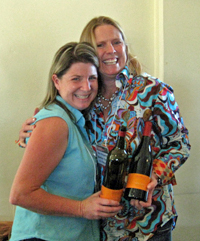 |
Martian Ranch 2012 Albariño, “Uforic,” Santa Barbara County. Whole-cluster pressed and fermented in stainless steel and foudre, then aged on the lees in foudre. Light straw color, featuring bright citrus fruit, fresh herbs, flowers, and lees on the nose. Medium-light weight with vibrant acidity and a clean finish, nice.
Martian 2012 Grenache Blanc, “Mothership,” Santa Barbara County. Whole-cluster pressed and fermented in stainless steel and foudre, then aged on the lees in foudre. Very light color, this had aromas of apple and citrus, plus stony mineral notes. Medium-light bodied, combining a bright mouthfeel with a slightly creamy texture and crisp finish, nice.
Martian Ranch 2012 Grenache Noir, “Local Group,” Santa Barbara County. 84% Grenache, 9% Mourvèdre, 4% Syrah, 2% Grenache Blanc, 10% whole-cluster fermentation. Lighter garnet color, with earth, flowers, fresh red fruits, and dried herbs, along with a hint of sweet oak. Medium-bodied with moderate tannins on the finish.
Martian Ranch 2011 Tempranillo, “Gravitas,” Santa Barbara County. Entirely destemmed, and aged in mostly neutral oak. Medium-dark purple, this had riper plum and herb aromas plus earth and black pepper notes. Richer mouthfeel, this finished with big, grippy tannins.
Comments: The Martian name is a combination of the names of owner Nan Helgeland’s sons Martin and Ian. Nan was on hand to pour her wines at the event. The 2011 wines are the first releases from the biodynamically-farmed estate vineyard near Los Alamos.
|
Pierce Ranch Vineyards
Pierce Ranch 2012 Albariño, San Antonio Valley. Made mostly in stainless steel along with some neutral oak. Light straw color, displaying bright and ripe stone fruit and tropical fruit on the nose. Medium-light bodied with a fairly smooth texture and finish.
Pierce Ranch 2011 Arinto, San Antonio Valley. Fermented in stainless steel and aged in neutral oak. Light straw color, with fresh herbs, apple and citrus fruit, and a touch of flowers. Medium-light weight with a vibrant mouthfeel and lively finish, nice.
Pierce Ranch 2012 Verdelho, San Antonio Valley. Light color, this had aromas of fresh peach and apricot along with a touch of orangepeel. A bit rounder mouthfeel than the previous two wines, with a smooth finish.
Pierce Ranch 2011 Garnacha, San Antonio Valley. Light garnet color, showing higher-toned red fruit, earth, and lots of spice. Medium-bodied, finishing with milder tannins.
Pierce Ranch 2011 Graciano, San Antonio Valley. 100% Graciano. Medium purple color, with earth, black cherry and darker fruit, spice, and a hint of tomato on the nose. Medium-full bodied with a firm tannic finish.
Pierce Ranch 2010 Tempranillo, “Reserve,” San Antonio Valley. Aged in about 50% new oak. Medium color, this featured more vanilla/oak and spice aromas, plus plummy fruit and a smoky note. Big and structured, with chewy tannins on the finish.
Comments: First planted in 1999, Pierce Ranch has become one of California’s top vineyards for Iberian grape varieties, and their own wines have been very solid over the years. All of the fruit comes from the Pierce Ranch estate vineyard in the San Antonio Valley of southern Monterey County. The Arinto is a rare varietal bottling in California.
Quinta Cruz
Quinta Cruz 2012 Albariño, Bokisch Vineyard, Clements Hills. Very light color, displaying bright grapefruit and fresh herb aromas, plus a briny note. Lighter-bodied with a vibrant mouthfeel and crisp finish, nice.
Quinta Cruz 2012 Verdelho, Silvaspoons Vineyard, Alta Mesa. Light straw color, this had more intense ripe stone fruit and tropical fruit on the nose. Medium-light weight in the mouth, with a fresh but slightly tart finish.
Quinta Cruz 2009 Touriga, Pierce Ranch, San Antonio Valley. 82% Touriga Nacional and 18% Touriga Franca. Medium-light purple, this had plum, flowers, earth, and spice aromas. Medium-bodied with a lively texture and fine tannins, nice.
Quinta Cruz 2010 Graciano, Bokisch Vineyard, Clements Hills. 100% Graciano. Medium-dark color, displaying Graciano’s funky/earthy side along with darker berry fruit and herbs. Big and structured, with fairly aggressive tannins on the finish.
Quinta Cruz 2011 Tempranillo, Pierce Ranch, San Antonio Valley. 100% Tempranillo. Medium purple color, showing more sweet oak than the other Quinta Cruz reds, along with red fruits, earth, and a touch of tobacco/dried herbs. Medium-full bodied, with firm tannins.
Quinta Cruz 2010 Souzão, Silvaspoons Vineyard, Alta Mesa. 100% Souzão. Dark purple, with ripe plum, earth, and spice on the nose. Fairly full-bodied, finishing with big, chewy tannins.
Comments: Established in 2008 to showcase Iberian grape varieties, Quinta Cruz is the sister winery of well-known Santa Cruz Mountain Vineyard. They presented a good group of wines once again this year at TAPAS. Fruit is sourced from Pierce Ranch in southern Monterey County and from Bokisch and Silvaspoons vineyards in Lodi.
Riaza Wines
Riaza 2012 Verdejo, Heringer-Holland Vineyard, Clarksburg. Light straw color, this had earthy and chalky mineral notes plus pear and spice aromas. Medium-light weight with a lively mouthfeel and finish, nice.
Riaza 2013 “Tres Viñas,” California (tank sample). First white blend from Riaza, 60% Verdejo from Clarksburg, 20% each Albariño and Verdelho from Bokisch Vineyards in Lodi, this was bottled the day after the tasting. Very light straw color, showing ripe pear and melon with hints of fresh herbs and flowers. Medium-bodied with a long, smooth finish.
Riaza 2011 Tempranillo, Bray Vineyard, Amador County. Medium purple, with ripe and higher-toned black cherry fruit, plus spice, earth, and sweet oak. Medium-bodied, this finished with moderate tannins.
Riaza NV “Viña Selecta,” California. Mostly Tempranillo, plus Graciano and Garnacha sourced from Lodi, Amador, and Clarksburg, from the 2010 and 2011 vintages. Medium color, displaying a bigger vanilla/oak component along with dark berry fruit, spice, and some tobacco/dried herb notes. Medium weight with a richer texture and grippier tannic finish.
Riaza 2011 Graciano, Terra Alta Vineyard, Clements Hills-Lodi. 100% Graciano, aged entirely in French oak. Medium purple, aromas of ripe plum and black cherry, earth, lots of spice, and touches of dried herbs and pepper. Medium weight in the mouth, this was lively and structured, finishing with firm tannins.
Riaza 2011 Monastrell, Amador County. Medium-light color, featuring herbs, plum and darker berry fruit, iron/mineral, and spice on the nose. Medium-bodied with bright acidity, this had a long finish with big but refined tannins, nice.
Comments: Rick and Erin Taylor established Riaza Wines in 2008, and they specialize in wines from Spanish varieties sourced from Lodi, Clarksburg and the Sierra Foothills. Rick poured a solid line-up of wines, and this is a newer winery that should be worth watching.
St. Amant Winery
St. Amant 2013 “Miss Independent” Verdelho, Amador County. Very light color, with pretty floral aromatics along with stone fruit and tangerine. Medium-light bodied with a vibrant mouthfeel and clean finish, nice.
St. Amant 2012 Souzão, Amador County. Medium-dark color, this displayed dark berry fruit, earth, spice, and vanilla/oak on the nose. Medium-full bodied with a fairly lively texture and fine tannins.
St. Amant 2003 Tempranillo, Amador County. Big, fruit forward nose of dark cherries and blackberries, anise, vanilla, and fairly soft, chalky tannins. (Tasted at the Tempranillo seminar)
St. Amant 2012 “The Road Less Traveled” Tempranillo, Amador County. Not yet released but St. Amant’s Stuart Spencer chose to pour it because their 2011 is somewhat atypical, aged 18 months in American oak with 35% new and blended with a little Souzao. Forward nose of dark and red cherries and plums, like a younger version of the 2003 with more noticeable tannins that are still round and beginning to integrate. (Tasted at the Tempranillo seminar)
St. Amant 2011 “The Road Less Traveled” Tempranillo, Amador County. Medium purple color, this was savory and spicy, with plum and blueberry, herbs, and a touch of oak. Medium-rich mouthfeel and good structure, with moderate tannins and a long finish, nice.
Comments: St. Amant was established in 1981 by the Spencer family, and Stuart Spencer (current TAPAS president) and his mother Barbara were on hand again to pour their wines. The fruit for their Iberian-variety wines comes from the family’s vineyard in Amador County. The wines have been solid and consistent over the years, with the Verdelho being a favorite this time. I missed out on St. Amant’s fine Port-style wines this year.
Starr Ranch
Starr Ranch 2011 Grenache, “Reserve,” Estate, Paso Robles. Medium-light garnet color, with ripe and higher-toned cherry fruit, plus earth and oak notes. Medium weight with fairly lively acidity and moderate tannins on the finish.
Comments: Starr Ranch was planted in 2002 in the Adelaida Hills area west of Paso Robles. The vineyard includes Bordeaux, Rhône, and Iberian grape varieties, and they sell fruit to a number of local wineries. Starr Ranch began producing wine under their own label with the 2006 vintage.
Tejada Vineyard
2007 “Tejada Reserve,” Lake County. Tempranillo-based wine. Medium-dark color, showing ripe plum, earth, spice, and sweet oak on the nose. Medium-full bodied, this finished with firm but refined tannins.
Comments: Celia, Ibo, and Nina Tejada planted their Lake County vineyard in 2000, and farm it organically. They grow Grenache and Tempranillo there, though they produce only Tempranillo for their own label.
Triple Oak Vineyard
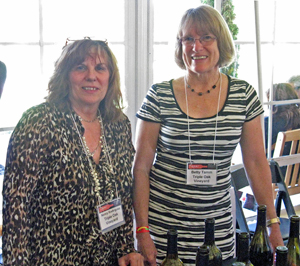 |
Triple Oak 2010 Tempranillo, Umpqua Valley, Oregon. Medium purple color, with smoky and savory aromas along with black cherry and a touch of spice. Medium-bodied, this finished with moderate tannins.
Triple Oak 2011 Tempranillo, Umpqua Valley, Oregon. Medium-light color, this featured plum and black cherry fruit, flowers, earth, and dried herbs on the nose. Medium weight on the palate with a lively texture, finishing with firm but refined tannins, nice.
Triple Oak 2012 Tempranillo, Umpqua Valley, Oregon. Medium-light purple, displaying bright black cherry aromas, plus earthy and savory herbal components. Medium-bodied with bright acidity and a long, fresh finish with moderate tannins, nice.
Comments: Triple Oak proprietors Paul and Betty Tamm planted their vineyard in 2000 to Pinot Gris, Gewürztraminer, Pinot Noir, and Tempranillo, and made their first commercial wine from the 2005 vintage. They’re a tiny producer, making only a couple hundred cases each year. And the name doesn’t mean the wines are oaky (far from it, as a matter of fact) – it’s derived from their location on Oak Street in the town of Oakland, Oregon, plus the fact that Tamm is Estonian for “oak.” Triple Oak was a new producer to me, but their Tempranillos made quite an impression.
Turkovich Family Wines
Turkovich 2012 Albariño, Yolo County. 100% Albariño, made entirely in stainless steel. Very light color, with ripe pear and stone fruit aromas. Medium-rich mouthfeel, with smooth and pleasant finish.
Turkovich 2011 Tempranillo, Yolo County. 100% Tempranillo, aged in 16% new American oak puncheons. Medium purple, this showed ripe plum and black cherry fruit plus lots of vanilla/oak and spice on the nose. Medium-full bodied and structured, with chewy tannins on the finish.
Comments: Established in 2007 by grower/winemaker Chris Turkovich and his family, the estate vineyard is located in the Winters area of Yolo County, just over the Vaca Mountains from Napa. The winery has focused mainly on wines made from Iberian, Rhône, and Bordeaux grape varieties.
Twisted Oak Winery
Twisted Oak 2003 Tempranillo, Calaveras County. A blend of 81% Tempranillo (Rolleri vineyard), 10% Cabernet Sauvignon (Vallecito), 8% Garnacha (Bokisch Ranch). Ripe dark cherries and currants, tobacco, still has some fairly grippy tannins despite the age. (Tasted at the Tempranillo seminar)
Twisted Oak 2011 Tempranillo “Zilch”, Calaveras County. In some vintages, Twisted Oak produces a small volume barrel select Tempranillo called Zilch. It’s like a reserve wine, but it’s not labeled reserve because Twisted Oak’s Jeff Stai thinks reserve means zilch. 100% Tempranillo from their estate Vallecito vineyard, dark berries, cherries, and Caribbean spice, vanilla, and fresh acidity. Still young, probably needs a year or two to hit its peak. (Tasted at the Tempranillo seminar)
Comments: Twisted Oak was founded by Jeff Stai and his wife Mary in 2001, and the winery has been among the leaders in California wines made from Iberian grape varieties over the years. I had tasted a number of the Twisted Oak wines during a visit there late last year, so I limited my tasting to wines I had not tried before.
Upper Five Vineyard
Upper Five 2011 Tempranillo, Rogue Valley, Oregon. Medium purple color, with fresh plum and black cherry fruit, earth, spice, and a touch of vanilla/oak. Medium-bodied with a bright mouthfeel and big, grippy tannins – this could use some time in the bottle but shows promise.
Comments: Upper Five’s 2010 Tempranillo was the winery’s first release. Proprietor Terry Cooper Sullivan planted his vineyard in 2003 and it’s been certified organic since 2005. He also grows Sauvignon Blanc, Grenache, and Syrah there – most of the fruit is sold to other wineries, though Upper Five produced a Sauvignon Blanc in 2013.
Verdad Wine Cellars
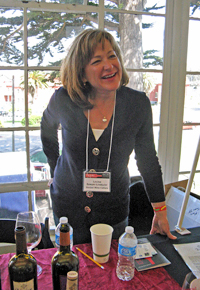 |
Verdad 2013 Grenache Rosé, Sawyer Lindquist Vineyard, Edna Valley. Made in 50% each stainless steel and neutral oak. Light salmon/pink, this had fresh strawberry aromas plus touches of flowers and fresh herbs. Fairly light-bodied with a vibrant texture and a chalky mineral note on the crisp finish, nice.
Verdad 2013 Albariño, Sawyer Lindquist Vineyard, Edna Valley. Made in 75% stainless steel and 25% neutral oak, bottled ten days before the tasting. Light straw color, featuring bright citrus and stone fruit, flowers, and a hint of wet stones. Medium-light weight, with a lively mouthfeel and finish, nice.
Verdad 2012 Albariño, Sawyer Lindquist Vineyard, Edna Valley. Made in 75% stainless steel and 25% neutral oak. Light straw, with riper stone fruit on the nose than the previous wine, plus a spicy component. Slightly richer mouthfeel but retaining good acidity and a clean finish.
Verdad 2012 Graciano, Ibarra-Young Vineyard, Santa Ynez Valley. 85% Graciano, 15% Tempranillo, aged in three-year old puncheons. Medium-light purple, this showed earthy black cherry, dried herb, and mildly floral aromas. Medium-light bodied with a bright texture and moderate tannins, nice.
Verdad 2004 Tempranillo, Santa Ynez Valley. This is the fourth Tempranillo based wine made at Verdad, but the first with high enough Tempranillo content to be labeled as a varietal wine. Comprised of 75% Tempranillo (Rioja clone from Ibarra-Young), 15% Syrah (Bien Nacido), 10% Grenache, aged in a mix of Hungarian and François Frères oak barrels. Lively dark cherry and plum, with peppery spice, herbs, and a touch of chocolate. This was apparently quite tannic in its youth, but is quite approachable today. (Tasted at the Tempranillo seminar)
Verdad 2010 Tempranillo, Sawyer Lindquist Vineyard, Santa Ynez Valley. The 2010 season in Edna Valley began with intense winds during flowering that reduced the set by 50%. It was cool with little sun during most of the growing season, then a late season spell of heat ripened the fruit while retaining good acidity. 84% Tempranillo (Pesquera clone), 16% Grenache to elevate the aromatics, aged in 30% new François Frères and Ermitage barrels. Dark berries and currants with a little red fruit, a juicy mid-palate and beautiful acidity. (Tasted at the Tempranillo seminar)
Verdad 2009 Tempranillo, Sawyer Lindquist Vineyard, Edna Valley. 84% Tempranillo, 16% Grenache, aged 18 months in 30% new French oak. Medium purple, this brought the savory and herbal components up front, with earth, cherry, and a touch of smoky oak in support. Medium-bodied, finishing with big but refined tannins, nice.
Comments: Louisa Sawyer Lindquist poured her Verdad wines, and she presented one of the strongest line-ups at the TAPAS tasting. Louisa and Verdad have been specializing in wines made from Iberian grape varieties since 2000. Sawyer Lindquist Vineyard in southern Edna Valley was planted in 2005 and is farmed biodynamically – its fruit has led to some outstanding wines in recent years.
Vinateria Idilico
Idilico 2013 Albariño, Yakima Valley, Washington. Light straw color, with somewhat shy stone fruit and spice on the nose. Moderately rich, creamy texture with a smooth finish.
Idilico 2011 Graciano, Upland Vineyard, Snipes Mountain, Washington. Medium purple color, showing ripe red fruits and dried herbs with a touch of forest floor. Medium-full bodied, finishing with grippy tannins.
Comments: Vinateria Idilico is the sister winery of Pomum Cellars in Washington. Idilico is a rarity – it’s currently Washington’s only winery producing exclusively wines from Iberian grape varieties, and the wines are made by a native of Spain, owner/winemaker Javier Alfonso.
Vincent Arroyo Winery
Vincent Arroyo 2011 Tempranillo, Estate, Napa Valley. Medium-dark purple, this displayed darker berry fruit, earth, dried herbs, with a framework of sweet oak. Big and structured in the mouth, with plenty of tannic grip on the finish – this will need time in the cellar.
Comments: Vincent Arroyo has been farming his vineyard just north of Calistoga and making wines there since the mid-1970’s. The winery has been particularly noted for its fine Petite Sirahs and blends over the years, but 2009 marked their first vintage of Tempranillo.
|



